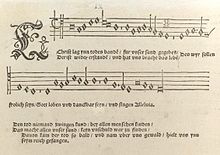Christ lag in Todesbanden
| "Christ lag in Todes Banden" | |
|---|---|
| Hymn by Martin Luther | |

"Christ lag ynn todes bande" in Eyn geystlich Gesangk Buchleyn of 1524
|
|
| English | Christ lay in death's bonds |
| Occasion | Easter |
| Language | German |
| Melody | by Luther and Johann Walter |
| Published | 1524 |
"Christ lag in Todesbanden" (also "... in Todes Banden"; "Christ lay in death's bonds") is an Easter hymn by Martin Luther. Its melody is by Luther and Johann Walter. Both the text and the melody were based on earlier examples. It was published in 1524 in the Erfurt Enchiridion and in Walter's choral hymnal Eyn geystlich Gesangk Buchleyn. Various composers, including Pachelbel, Bach and Telemann, have used the hymn in their compositions.
In early editions the hymn, in seven stanzas, was indicated as an improved (German: gebessert) version of "Christ ist erstanden". The hymn is in bar form. The Stollen, that is the repeated first part of the melody, sets two lines of text for each repetition, with the remaining four lines of each stanza set to the remainder of the melody.
The hymn celebrates the Resurrection of Jesus, with particular reference to a struggle between Life and Death. The third verse quotes from 1 Corinthians 15, saying that Christ's Atonement for sin has removed the "sting" of Death. The fifth verse compares the sacrifice with that celebrated by Jews in the Pascal Lamb at Passover. The sacrificial "blood" ("Its blood marks our doors") refers to the marking of the doors before the exodus from Egypt. The final stanza recalls the tradition of baking and eating Easter Bread, with the "old leaven" alluding again to the exodus, in contrast to the "Word of Grace", concluding "Christ would ... alone nourish the soul."
...
Wikipedia
